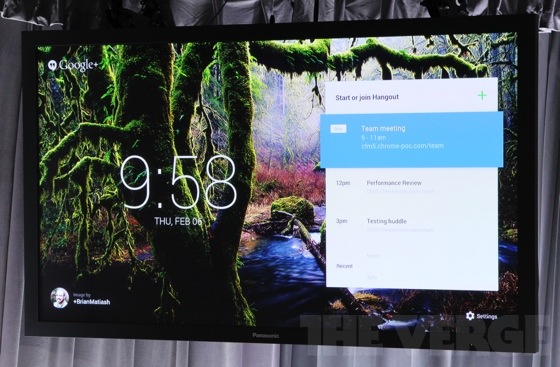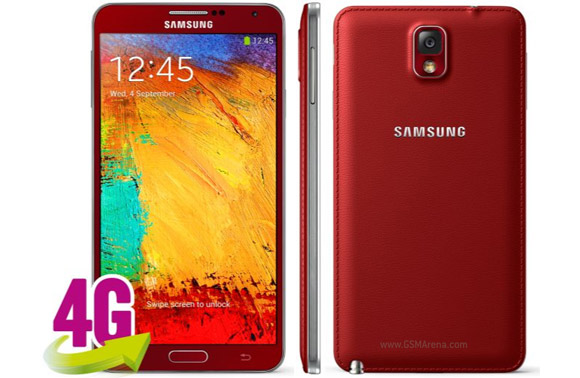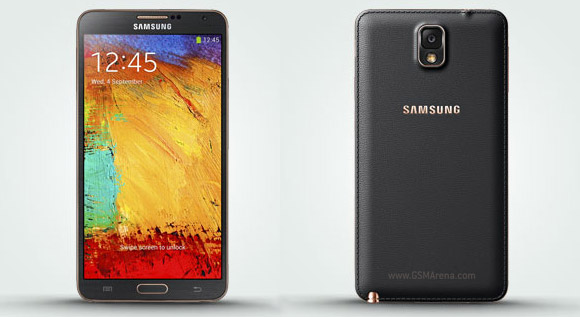
Google's $35 Chromecast dongle made it cheap and easy to show off YouTube videos on your TV. Now, the company sees another narrow window of opportunity for Chrome: teleconferencing. "Audioconferencing takes pain to a completely new level," says Caesar Sengupta, VP of product development for Chrome. Today, the company plans to fix that with a $999 kit that uses a souped-up Intel Core i7 Google Chromebox and $250-a-year Google cloud services to make setup as painless as possible. "It takes minutes to go from a full packaged box to a meeting room that's ready to go," says the exec.
The Chromebox for Meetings package comes with a collection of off-the-shelf components, including a Logitech HD webcam, a Jabra speakerphone, and a Boxee-like remote control with a keyboard on the back. It uses Google+ Hangouts for video chat such that any Gmail user can join a meeting from any laptop, tablet, or smartphone anywhere in the world. Conference organizers can start and attendees can join a meeting with a single button press on the remote control, or even remotely.
Once a meeting room is set up with one of the Chromeboxes over ethernet or Wi-Fi, says Sengupta, there will also be no confusion over when the meeting room is in use: the service syncs with Google Calendar (or, in the future, with a Microsoft Exchange plug-in) to prominently display the schedule of upcoming meetings, and allow a user to start a new meeting just by typing a new meeting name into the terminal with the keyboard on the back of the remote.
The system also tries to address pain points of meetings running too long, by reminding speakers when the next meeting is scheduled to begin, highlights users who are currently speaking, and will notify people who speak up if they happen to be muted to avoid embarassment. While the software is free for the first year, the company plans to charge a $250 annual management and support fee per device to maintain the service and provide 24/7 assistance.

"IF YOU’VE NEVER BEEN KISSED BY YOUR CFO BEFORE, HERE’S YOUR CHANCE."
While $999 might seem a little expensive for a Chromebox kit and some off-the-shelf teleconferencing components, particularly when such a box retails for $179 without the pricy Core i7 chip, Sengupta reminded press that competing enterprise teleconferencing solutions can cost quite a bit, allowing companies to purchase many Chromebox for Meeting packages for the price of an executive teleconferencing solution. "If you've never been kissed by your CFO before, here's your chance," he quipped. Sengupta says the Core i7 processor is necessary to process and encrypt many simultaneous streams locally, and that normal Chromeboxes won't be able to host the service as a result.
Chromebox for Meetings is available today in the US with Chromebox hardware from Asus, with HP and Dell adding hardware in the coming months. Australia, Canada, France, Japan, Spain, UK and New Zealand availability is coming later this year, according to the company.
When asked by press at the product unveiling, Sengupta said the new Chromebox for Meetings shouldn't be construed as a plan to expand the Chrome hardware business to other platforms per se. "We don't really think of this as just a way to enter a new space for us, we saw this problem that needed to be addressed," he replied.
"We're always on the lookout for problems that exist in the market today."

Already available in the US unlocked, as well as via Verizon and Boost Mobile, Motorola’s affordable Moto G might land at U.S. Cellular in the near future.
According to a screenshot revealed by Android Central, U.S. Cellular will start selling the Motor G to its no-contract customers on February 10 - for a price that hasn’t been disclosed. Verizon is currently selling the Moto G off contract for only $99.99, so maybe US Cellular’s version will be priced similarly.
The Moto G should have Android 4.4 KitKat on board when it launches at U.S. Cellular and, of course, it'll bring all the nice features we’re already familiar with: a 4.5-inch display with 720 x 1280 pixels, quad-core Qualcomm Snapdragon 400 processor clocked at 1.2GHz, 5MP rear camera, 1GB of RAM, 8GB / 16GB of internal memory, and a 2,070 mAh battery. At less than $200, no contract required, the Moto G is a steal, and you’ll have a really hard time finding a better smartphone in the same price range.
As you may have heard, Google agreed to sell Motorola Mobility to Lenovo (subject to regulatory approval) - but this shouldn’t affect current Motorola products in any way.
source: Android Central

Today, Lawrence Livermore National Laboratory joined the cutting edge of laser research, receiving $45 million dollars to build a laser system of unprecedented power for a European Union project outside of Prague. The project, called ELI-Beamlines, is developing something called a "High repetition-rate Advanced Petawatt Laser System" (HAPLS), which employs short, frequent bursts of intensely high-powered lasers reaching power greater than 1,000,000,000,000,000 watts. If successful, it will be the most powerful laser ever constructed.
With funds in place, construction is expected to begin immediately. The Czech Institute Of Physics will help to construct the device at Livermore until it can be completed and shipped to the Beamlines facility in Dolni Brezany in 2016. After that, the project will open up to the research community at large. Researchers expect the laser's unique energy density to enable new projects in medical imaging, particle acceleration, and quantum physics, among other fields. See an official EFI-Beamlines video describing the project below.

Yes, folks, this is real life. In an interview with Wired, at the Apps World North America conference, Steve Wozniak revealed his belief that Apple should create a phone using Google's Android operating system. According to him, "There's nothing that would keep Apple out of the Android market as a secondary phone market ... We could play in two arenas at the same time." As Wired's Mat Honan notes, the idea of such a handset wouldn't be technically impossible, but anyone who's familiar with the Apple of today knows that the chances of this actually happening are slim to none.
"We [Apple] could compete very well. People like the precious looks of stylings and manufacturing that we do in our product compared to the other Android offerings," Wozniak stated during the interview. Of course, this isn't the first time(and very likely won't be the last) in which the great, legendary Woz has spoken openly about his thoughts on Apple- and Android-related affairs -- still, it's always interesting to hear his perspective on the tech industry. Wozniak also spoke toWired about the film Her, Moore's Law and even why he thinks the Cupertino company has yet to release a smartwatch or TV. You can check out the full interview right here.

The GSA organization just released a map of the next LTE milestone reached - deployment in 100 countries worldwide. You only need to take one look at the map to determine that LTE is going mainstream.
There are currently 268 commercially available 4G LTE networks, and GSA forecast this number to reach the whopping 350+ carriers by the end of the year. another interesting tidbit is that almost half of those networks are using the LTE1800 band, and in total the LTE subscribers are closing in on the 160 million mark.
The phones and tablets with the widest LTE band support are currently made by Apple, as it has to sell one and the same product across the globe, so its iPhones and iPads sport a record number of bands coverage inside their tiny Qualcomm radios.
The iPhone 5s and 5c models sold on Sprint offer 13-band LTE support, including the valuable LTE1800. The record, however, goes to the newest iPads - the Air and the mini - which cover 21 bands, so theoretically you can use them with fast download speeds in most of the countries you see painted in red on this map above.
source: GSA

Modern cars all have so many computerized accessories and safety systems inside that they need a computer brain to control things. The problem is that these computer brains are often not secure at all leaving them vulnerable to hackers. A pair of security researchers have devised a device that can hack the computer inside a car and takeover systems.
The researchers are Javier Vazquez-Vidal and Alberto Garcia Illera and they have cooked up a small handheld device using off the shelf and readily available components that is able to hack the computer brain in modern cars. The researchers say that their little device takes less than five minutes to hook to the car.
The off the shelf parts needed to build the car hacking device can be purchased for under $20. The systems the device can compromise vary depending on the car attacked. The researchers call their hacker tool the CAN Hacking Tool because it attacks the Controller Area Network bus. In tests, the duo has used the device on four different cars. They have been able to manipulate lights, turn on car alarms, control the power windows, and activate the brakes of the car.
Having control of the lights and brakes certainly means a nefarious hacker could potential cause an accident, possibly leading to death for driver or passengers. The researchers say that they want to create a version of the hacking tool with a GSM radio that would allow the vehicle systems to be controlled remotely. The duo says that they want their demo at Black Hat Asia to get automakers attention and will keep the source code for the tool private for now.
SOURCE: Engadget









